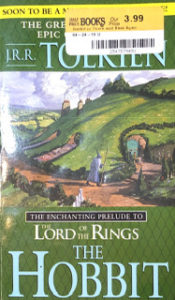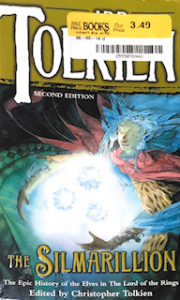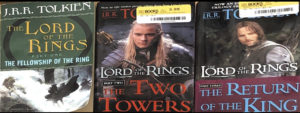Welcome to the cKotch.Com blog. I’m Christopher Kotcher, and this is The Written World. Time to explore the worlds which writers have made.

Always the Two
I grew up learning about two great writers who founded the modern fantasy genre.
C.S. Lewis most famously wrote The Chronicles of Narnia. He wanted to create a fantastical world to communicate his Christian apologetics.
J.R.R. Tolkien founded Middle Earth. He meticulously crafted the world of The Lord of the Rings, which has been a true achievement across literature, film, and even videogames.
A brief while back, I covered a third founder of fantasy, the often-forgotten George MacDonald.
My main idea there was to recognize MacDonald’s steps between classic fairy tale and modern fantasy. He is a crucial link in the literary chain.
Now I wish to cover one of the two more popular founders of fantasy, and I have settled on Tolkien.
This was no easy decision. Lewis and Tolkien were true kindred spirits.
Both were pioneers inspired by MacDonald. Both were professors. Both were part of the famous writers’ group, the Inklings.
However, I have read more of Tolkien’s books, five from him compared to three from Lewis.
Also, most of my reading from Lewis hasn’t been from Narnia. I’ve actually read more of his Christian apologetics than his fantasy. The Screwtape Letters and Mere Christianity are both classics.
Meanwhile, I’ve read all of The Lord of the Rings trilogy, the whole of The Hobbit, and the totality of The Silmarillion.
I do not pretend to provide a comprehensive view within 1500-2000 words. Whole courses are taught on Tolkien’s books. One post alone couldn’t cover all there is to cover.
Here, I wish to discuss Tolkien’s works in terms of worldbuilding trends. We’ll see how Tolkien further develops the world building tools MacDonald pioneered.
Our ultimate goal in this post is achieving a better understanding of how one writer influenced the other.
With that focus in mind, let’s begin with the first published book on Middle Earth, The Hobbit.
The Original Tale

We start with the first published work about Middle Earth.
The Hobbit is the closest of Tolkien’s works to a fairy tale. In fact, it is such a fairy tale, Tolkien once considered revising it to better match the epic scale and tone of The Lord of the Rings.
What do I mean by calling this first book a fairy tale? What makes the quest of Bilbo Baggins so different from that of his nephew Frodo?
I mean the world is not established the same way here as in Tolkien’s other tales from Middle Earth.
Magic happens because magic happens. Very little needs to be explained in careful detail.
Wizards simply exist. Gandalf doesn’t have to belong to some ancient land beyond Middle Earth.
A dragon’s gold is cursed merely because it belonged to a dragon. There’s no real mechanics to the hex.
Even the great Ring of Power, the One Ring to Rule Them All, the relic of the Dark Lord Sauron’s terrible power, is just a magic ring here.
Bilbo takes the ring from the cave-dwelling Smeagol. The item becomes one more tool in the adventurer’s pocket with little consequence. He turns invisible as he pleases and faces only minor repercussions in the story.
Even the nature of the plot is fundamentally different from The Lord of the Rings.
Frodo quested to save Middle Earth from an age-old evil. Bilbo was recruited to be a burglar for some dwarves seeking treasure.
The purpose of Bilbo’s story is not to fulfill a noble mission. It is to learn a few lessons in courage and comradery during a grand journey.
Now, if The Hobbit is such a fairy tale, how does it continue MacDonald’s development between fairy tale and fantasy?
The answer there would be simple. Tolkien removed the real world.
Traditionally, fairy tales begin with entry into the woods or the appearance of magic. They end with an exit from the woods or the disappearance of magic.
MacDonald first twisted that ending in his tale The Golden Key. Its characters Mossy and Tangle didn’t return home. They ended up in a heavenly land beyond both reality and fantasy.
Tolkien goes one step further in The Hobbit. He begins and ends in a fantastical world.
Middle Earth is not a world entered or left. It is a place all its own.
Even the star of the story is somewhat revolutionary. Generally, fairy tales star humans, particularly children or adolescents.
Bilbo isn’t a human. He’s a creature of Tolkien’s creation, a hobbit. He’s small, but he’s no child. He would be a young man in Hobbit years here.
If anything, Bilbo would be most similar to Anodos from MacDonald’s Phantastes. Their primary lesson is moving past old assumptions and ideals.
While Anodos learned the flaws in his lofty ideas of love, Bilbo learned to value a simple life with some adventure rather than an easy life without any room for growth.
The Published Notes

In The Silmarillion, we move on to a different kind of fantasy book.
For one, this collection of legends was published forty years after Tolkien’s death. His son edited this book and released it.
Most Middle Earth tales occur during the world’s Third Age. This book describes events from the earlier ages.
The One Ring of Sauron is the source of conflict in the Third Age. In earlier ages, the first dark lord Morgoth steals three sacred jewels, the Simarils.
To save Middle Earth in the Third Age, the One Ring is destroyed in the fires of Mount Doom. In earlier ages, the Simarils are scattered in the stars, under the Earth, and beneath the sea. They will be found again at the end of days.
The War of the Ring is fought to destroy evil. The War of the Jewels is fought to claim goodness.
Alongside the book’s main legend, additional legends are included. These show the rise of Sauron and the buildup to the Third Age.
Now, why would I cover this book first in a discussion of Middle Earth? How does all this show a connection to MacDonald?
I answer these questions with another. Do you remember what I said about Tolkien begin a meticulous crafter of worlds?
Middle Earth existed in mind and in notes far before the first word of the first book was written.
When Tolkien was first asked to write a sequel to his book The Hobbit, he originally presented his publisher with the notes for The Silmarillion.
In fact, The Lord of the Rings trilogy is actually based on the short final legend in The Silmarillion, “Of the Rings of Power and the Third Age.”
Recall from my prior post that one of MacDonald’s chief innovations was creating fantastical worlds with their own internal rules.
Classic fairy tales didn’t need logic. Their worlds simply needed to facilitate the moral of the story. This would be why there is much discrepancy in classic depictions of any fairy creature.
MacDonald made worlds that functioned outside of characters’ lives. Owl fish were always being made by Grandmother and the Old Man and the Sea. You don’t need to be there for anything to happen in fairy woods.
Tolkien made a world with a history first. That world was the most important thing to him. Fitting stories into that world was secondary.
Tolkien made the first fantasy world specifically designed with room for an extended universe.
The Major Saga

Time has finally come for the grand show. Let’s tackle The Lord of the Rings.
This trilogy would be where Tolkien fully dives into creating a modern fantasy novel.
I say novel, singular, here because, in truth, The Lord of Rings was written to be one book. The work is split into a trilogy by publishers due to the otherwise massive size.
The story stars another hobbit, Frodo. He journeys to rid the world of the One Ring as Sauron rebuilds his forces in a bid to seize Middle Earth once more.
The world of Middle Earth is now ingrained in the story. All the writing, all the planning, it all comes together.
Gandalf and other wizards hail from the legendary land of Valinor. They are the Istari meant to guide Middle Earth in resisting evil.
A human ranger, Aragorn, is the destined king called to lead Middle Earth to a new era of prosperity.
Here Tolkien binds together the developments of The Hobbit and The Silmarillion. A great journey is told in a world with history.
Every song along the way, every struggle against evil, everything comes together here.
The shadowy Ring Wraiths are fairy tale phantoms given new literary meaning through their lore connection to the One Ring.
The songs sang along the road build all explore the wider story of Middle Earth.
The saga’s end especially shows Tolkien’s connection to MacDonald.
Years after his journey, Frodo’s spirit is left darkened from the effects of carrying the One Ring to Mount Doom. He is permitted to passage on an Elven ship to the sacred Undying Lands.
Here, Tolkien mirrors the ending of MacDonald’s Golden Key.
The ultimate end of the hero’s journey is not the return home. The hero is called to end in an eternal place beyond reality and fantasy.
Discussion Time!
I hope you have enjoyed my brief look into Tolkien’s great works.
As I said in the intro, there’s no way I could say everything about all these books here. This post merely shares my thoughts on how MacDonald inspired Tolkien to further develop fantasy.
Do you think I did well with the topic here? Are there any particular Tolkien topics you would like me to cover?
Of course, I’ll probably take a break from fantasy and fairy tales in this series for a bit. This is supposed to be my general series on books after all. I want to start including some other genres.
Kotcher’s Call to Action
If you like my content and wish to see more, you could check out my books Five Strange Stories and Good Stuff: 50 Poems from Youth on Amazon. They are enrolled in the Kindle Matchbook program, so anyone who buys the paperbacks can also get the eBooks for free.
Finally, be sure to like my Facebook page and share it with your friends. I post a link there whenever a new blog post goes live each Friday at 5:00 PM EST.